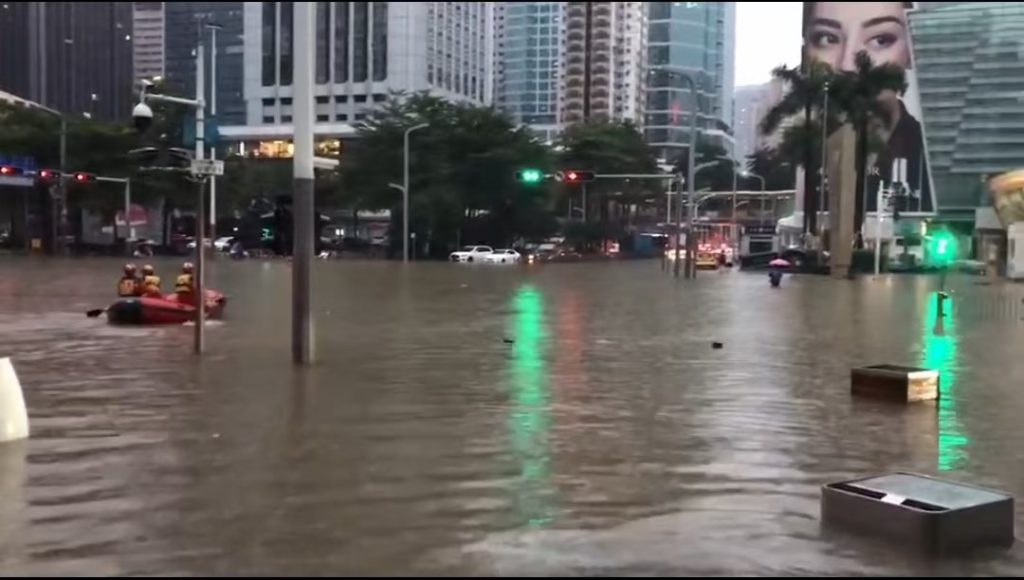In September 2023, Shenzhen City faced a heavy rainstorm. The rain was so intense that it caused a lot of damage. Underground garages, subway stations, and shopping malls were flooded with water. It looked like these places had turned into big water pool

Even more challenging, the rainstorm disrupted the city’s important infrastructure, causing problems everywhere. Water was everywhere, making things very difficult. Adding to the troubles, homes and businesses lost their electricity. This meant there was no power, and everything was dark. In this tough situation, it became clear how important emergency lighting can be to help people find their way and stay safe. The importance of maintaining emergency lighting system cannot be overstated in such critical moments, as it ensures reliable illumination when it’s needed most.
In times of crisis, when darkness engulfs a building, emergency lighting becomes a beacon of hope and safety. These lights have their power supply and are strategically placed to illuminate exit paths and vital safety signage, making them indispensable in ensuring the safety and security of occupants during emergencies.

In this extensive guide, we will delve into the world of emergency lighting, from its installation and legal implications to its various types and the benefits of proper maintenance. By the end of this article, you will have a thorough understanding of how emergency lighting serves as a critical lifeline in times of peril.
Imagine being inside a building when a sudden power outage occurs. The pitch-black surroundings can be disorienting and dangerous, especially if you need to evacuate quickly.
Emergency lighting addresses this scenario by automatically activating when the main power source fails. These lights are strategically positioned in common areas such as staircases and near fire escape signs, guiding occupants to safety.
Beyond its critical role in safety, emergency lighting is mandated by laws and building codes. Failing to comply with these regulations can lead to significant fines and penalties. Therefore, installing and maintaining emergency lighting is not only a matter of safety but also a legal obligation that should not be overlooked.
Before embarking on the installation of emergency lights, it is advisable to consult an electrician or hire a professional to ensure that all safety requirements are met. This step is crucial to ensure that the installation process adheres to relevant regulations.
Safety is paramount when working with electrical systems. Before beginning the installation, it’s imperative to switch off the electrical circuit you’ll be working on to prevent electrocution. Also, ensure that the fuse box is labeled “Do Not Energize.”
Emergency lights can be mounted in various ways, depending on the specific fixture. Some lights may need to be fully mounted before connecting the wiring, while others can be partially attached during installation. Fixtures can be secured using mounting brackets or by punching holes into wall studs for screws, depending on the type and design.
Explore the comprehensive emergency lighting installation, maintenance, and benefits guide for expert insights and guidance on ensuring the safety and reliability of your emergency lighting system.
When selecting emergency lights, consider LED options. LED emergency lights have a longer lifespan compared to traditional incandescent and halogen lights, making them a cost-effective choice.
Strategically plan the escape routes within your building or home, and install emergency lights to create efficient evacuation pathways. Consulting with a fire prevention firm can provide expert recommendations based on your building’s architecture and ensure compliance with OSHA standards.
Scheduled inspections with a fire prevention firm are essential to verify that all emergency lighting is functioning correctly and compliant with regulations. Maintenance ensures that these lights are ready to perform when needed most.
The primary purpose of emergency lighting is to enhance safety during evacuations. By providing adequate illumination, it reduces the risk of accidents, injuries, and panic during emergencies.
Complying with building codes and regulations regarding emergency lighting is not just a legal requirement but also a moral responsibility. Non-compliance can lead to fines, legal liabilities, and, more importantly, jeopardize lives.
An effective emergency lighting system can reduce liability in the event of accidents or injuries during evacuations. It demonstrates that you have taken reasonable steps to ensure the safety of occupants.
Knowing that your building is equipped with a reliable emergency lighting system provides peace of mind to both occupants and building owners. It fosters a sense of security and preparedness.
Emergency lighting comes in various forms, each serving specific purposes. The primary types include:
Maintained emergency lighting fixtures operate continuously alongside regular lighting systems. They can be manually switched to emergency mode or activate automatically when the main power fails. This type is commonly used in buildings where maintaining illumination is essential, such as hospitals and laboratories.
Non-maintained emergency lighting remains inactive during normal conditions and only activates during power outages. These lights are typically installed in areas where consistent illumination is not required, such as storage rooms and basements.
Sustained emergency lighting combines elements of both maintained and non-maintained systems. It provides continuous lighting in specific areas while only activating emergency lighting in other zones when needed. This approach balances energy consumption and safety requirements.
Understanding the science behind emergency lighting is crucial for designing and installing an effective system. Here are the key factors to consider:
Emergency lighting should provide sufficient illumination for safe evacuation. The required light levels vary depending on the location, occupancy, and potential hazards within a building. International standards, such as the Illuminating Engineering Society of North America (IESNA) guidelines, offer recommendations for appropriate light levels.
The duration of emergency lighting is critical. It should last long enough for occupants to safely exit the building or for emergency services to arrive. Backup power sources, such as batteries or generators, must be capable of supporting the required duration, which can range from 1 to 3 hours or more.
Also learn how to select the right battery for your emergency lighting needs with our expert guide.
Effective emergency lighting should ensure uniform illumination across exit routes, preventing areas of darkness or glare that could impede evacuation. Proper fixture placement and design are essential to achieve this uniformity.
Creating a robust emergency lighting system involves a combination of strategic planning, precise design, and careful implementation. Here are the key steps in designing such a system:
Start by evaluating the specific risks and hazards within your building. Consider factors such as occupancy, layout, and potential emergency scenarios. This assessment will help you determine the critical areas that require emergency lighting.
Identify primary and secondary escape routes within your building. Ensure that these routes are well-lit and clearly marked with illuminated exit signs. Exit paths should be free from obstructions and easily accessible.
Select emergency light fixtures that are appropriate for your building’s layout and requirements. Ensure that these fixtures meet regulatory standards and provide the necessary light levels for safe evacuation.
Regular testing and maintenance are essential to keep your emergency lighting system in optimal condition. Create a schedule for testing battery backups, replacing bulbs, and inspecting the entire system. Document these activities to ensure compliance with regulations.
Ensure that building occupants and staff are aware of the emergency lighting system and know how to use it effectively. Conduct drills and training sessions to familiarize them with evacuation procedures in low-light conditions.
Emergency lighting is not just a regulatory obligation; it is a critical element of building safety. A well-designed and maintained emergency lighting system ensures that people can exit a building safely during emergencies, preventing injuries and saving lives.
By understanding the principles behind emergency lighting and following best practices in its design and implementation, building owners and facility managers can contribute to a safer and more secure environment for all occupants.
So, when the lights go out, the path of egress remains illuminated, guiding everyone towards safety. In times of crisis, these lights serve as a lifeline, providing clarity and direction amidst chaos. As we delve deeper into the world of emergency lighting, let’s explore additional aspects, benefits, and best practices.
A well-designed and properly maintained emergency lighting system offers a multitude of benefits beyond the obvious enhancement of safety. Here are some compelling reasons to invest in an effective emergency lighting setup:
The primary purpose of emergency lighting is to ensure the safety of building occupants during emergencies. By providing consistent illumination in critical areas, it minimizes the risk of accidents, injuries, and confusion. People can confidently follow illuminated exit paths and safely evacuate the premises.
Compliance with building codes and safety regulations is non-negotiable. Emergency lighting is a fundamental requirement mandated by law to protect lives in commercial and residential buildings alike. Failing to meet these legal obligations can result in hefty fines and legal liabilities.
Having a reliable emergency lighting system in place can reduce liability in the event of accidents or injuries during evacuations. It demonstrates a commitment to safety and can mitigate potential legal consequences by showcasing due diligence in safeguarding occupants.
Knowing that your building is equipped with a robust emergency lighting system provides peace of mind to both building occupants and owners. This sense of security fosters a culture of preparedness and instills confidence in the safety measures in place.
Emergency lighting facilitates efficient evacuations by illuminating escape routes and exit signs. In times of darkness or smoke-filled environments, people can swiftly and calmly make their way to safety. This efficiency is particularly critical in high-occupancy buildings and public spaces.
Also Read: Why do you need emergency lighting systems in your building?
The importance of providing adequate light for evacuation cannot be overstated. When emergency lights are absent or insufficient, occupants may struggle to locate fire exits and navigate through unfamiliar spaces, especially during power outages or emergencies involving smoke or low visibility.
To ensure the safety of building occupants, it is essential to adhere to fire codes and safety standards. These regulations dictate the placement, type, and maintenance of emergency exit signs and lighting. Consulting with a fire protection contractor can help ensure compliance with these critical requirements.
Emergency exit lights should be connected to a separate power source, distinct from the building’s primary electrical supply. This ensures that the lights remain operational even when the building experiences a power outage. Multiple battery packs can be employed to extend the operating duration and enhance remote capacity.
Efficient evacuation pathways are vital in large buildings or facilities with complex layouts. Fire protection contractors can assist in the installation of LED exit signs along predetermined escape routes, ensuring that occupants can exit as quickly and safely as possible during emergencies.
Collaborating with a reputable fire protection company is invaluable when selecting and maintaining emergency exit lights. These professionals possess the expertise to recommend the most suitable emergency lighting solutions based on your building’s unique requirements. Moreover, they can ensure that your fire prevention system complies with all relevant fire regulations and standards.
The process of mounting emergency lights involves careful consideration and adherence to safety protocols. Here’s an overview of the steps involved:
Consultation: Seek advice from an electrician or professional to ensure compliance with safety standards and regulations.
Safety Precautions: Prioritize safety by disconnecting the electrical circuit you intend to work on. Ensure that the fuse box is clearly marked “Do Not Energize” to prevent accidental activation.
Mounting Options: Depending on the specific fixture, you may either fully mount the unit before connecting the wiring or partially attach it during installation. Emergency light fixtures are typically powered by alternating current (AC) at 120 or 277 volts, allowing the battery to charge while connected to the building’s power source and switching to battery power during outages.
In conclusion, emergency lighting is not merely a system of lights; it is a promise of safety, a legal obligation, and a guardian of lives. By embracing its principles and investing in its installation and maintenance, we fulfill our duty to protect and secure the path to safety for all.
Not sure what you required for your lightining project ?
Get in touch with us for FREE consultation.